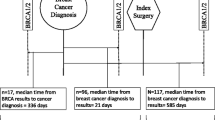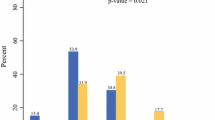Abstract
Background
Bilateral mastectomy in women diagnosed with unilateral breast cancer is on the rise in the USA. One contributing factor is increased awareness of contralateral breast cancer risk. Positive testing for deleterious mutation in BRCA1/2 is a concrete measure of this contributing factor. We hypothesize that breast cancer surgery trend change is temporally associated with the introduction of BRCA1/2 genetic testing around 1996.
Methods
Our study cohort included 158 BRCA1 or BRCA2 mutation carriers diagnosed with unilateral breast cancer between 1963 and 2009. Mutation carriers with ovarian cancer or bilateral breast cancer were excluded. Breast surgery and breast reconstruction surgery trends were analyzed according to year of breast cancer diagnosis or when bilateral mastectomy was performed, respectively.
Results
Surgery trends changed significantly over time. We observed a significant drop in the rate of unilateral mastectomy (P < 0.001) after the period 1996–2000, and the rate of bilateral mastectomy appears to be on the rise, up to 30.3% between 2006 and 2009. Breast reconstruction trends also changed significantly over time, with a significant rise in the rate of free flap reconstruction to 58.8% between 2006 and 2009.
Conclusions
Our results demonstrated a significant decrease in unilateral mastectomy with a rise in bilateral mastectomy after the period 1996–2000, a period which encompassed the year when genetic testing of the two BRCA1/2 genes became commercially available, hence supporting our hypothesis.
Similar content being viewed by others
References
Tuttle T, Habermann E, Grund E, et al. Increasing use of contralateral prophylactic mastectomy among breast cancer patients: a trend toward more aggressive surgical treatment. Ann Surg Oncol. 2007;14(2 supplement):7.
Tuttle TM. Management of the contralateral breast in women with breast cancer. Cancer Res. 2009;69 (Suppl.)(2):62s.
Throckmorton AD, Esserman LJ. When informed, all women do not prefer breast conservation. J Clin Oncol. 2009;27(4):484–6.
Sorbero ME, Dick AW, Beckjord EB, Ahrendt G. Diagnostic breast magnetic resonance imaging and contralateral prophylactic mastectomy. Ann Surg Oncol. 2009;16(6):1597–605.
Meijers-Heijboer H, van Geel B, van Putten WL, et al. Breast cancer after prophylactic bilateral mastectomy in women with a BRCA1 or BRCA2 mutation. N Engl J Med. 2001;345(3):159–64.
Tuttle TM. Magnetic resonance imaging and contralateral prophylactic mastectomy: the “no mas” effect? Ann Surg Oncol. 2009;16(6):1461–2.
Press N, Reynolds S, Pinsky L, et al. ‘That’s like chopping off a finger because you’re afraid it might get broken’: disease and illness in women’s views of prophylactic mastectomy. Soc Sci Med. 2005;61(5):1106–17.
Stolier AJ, Fuhrman GM, Mauterer L, et al. Initial experience with surgical treatment planning in the newly diagnosed breast cancer patient at high risk for BRCA-1 or BRCA-2 mutation. Breast J. 2004;10(6):475–80.
Schwartz MD, Lerman C, Brogan B, et al. Impact of BRCA1/BRCA2 counseling and testing on newly diagnosed breast cancer patients. J Clin Oncol. 2004;22(10):1823–9.
Weitzel JN, McCaffrey SM, Nedelcu R, et al. Effect of genetic cancer risk assessment on surgical decisions at breast cancer diagnosis. Arch Surg. 2003;138(12):1323–8; discussion 1329.
Metcalfe KA, Narod SA. Breast cancer risk perception among women who have undergone prophylactic bilateral mastectomy. J Natl Cancer Inst. 2002;94(20):1564–9.
Tuttle TM, Habermann EB, Grund EH, et al. Increasing use of contralateral prophylactic mastectomy for breast cancer patients: a trend toward more aggressive surgical treatment. J Clin Oncol. 2007;25(33):5203–9.
Metcalfe KA, Lubinski J, Ghadirian P, et al. Predictors of contralateral prophylactic mastectomy in women with a BRCA1 or BRCA2 mutation: the Hereditary Breast Cancer Clinical Study Group. J Clin Oncol. 2008;26(7):1093–7.
Acknowledgment
This study is supported, in part, by the American College of Surgeons Faculty Research Fellowship, Commonwealth Tobacco Funds (Health Research Formula Fund), and Grant #IRG-78-002-26 from the American Cancer Society (J.T.).
Disclosure
None.
Author information
Authors and Affiliations
Corresponding author
Rights and permissions
About this article
Cite this article
Mislowsky, A., Domchek, S., Stroede, C. et al. Breast Cancer Surgery Trend Changes Since the Introduction of BRCA1/2 Mutation Screening: A Retrospective Cohort Analysis of 158 Mutation Carriers Treated at a Single Institution. Ann Surg Oncol 18, 745–751 (2011). https://doi.org/10.1245/s10434-010-1381-9
Received:
Published:
Issue Date:
DOI: https://doi.org/10.1245/s10434-010-1381-9




